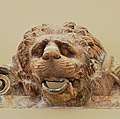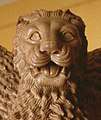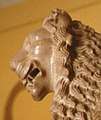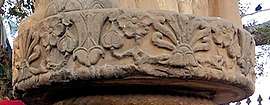Masarh lion
The Masarh lion is a stone sculpture found at Masarh, a village near Arrah town in the Bhojpur district in the Indian state of Bihar.[1] This sculpture is generally dated to the 3rd century B.C.
 The Masarh lion, in the Patna Museum. For a recent photograph: | |
 Shown within India  Masarh lion (Bihar) | |
| Location | Bhojpur District, Bihar, India. |
|---|---|
| Region | HINDU |
| Coordinates | 25.5578°N 84.5780°E |
Description
The lion is carved out of Chunar sandstone, similar to the Pillars of Ashoka, and has a polished finish, a feature associated with Maurya sculpture.[1] The sculptural style is Achaemenid.[1] This is particularly the case for the well-ordered tubular representation of whiskers (vibrissae) and the geometrical representation of inflated veins that cover the face.[1] The mane, with tufts of hair represented in wavelets, is classically represented.[1]
According to archaeologist S.P. Gupta, these visual features can be described as non-Indian.[1] Similar examples are known in Greece and Persepolis.[1] It is possible that this sculpture was made by an Achaemenid or Greek sculptor in India and either remained without effect, or was the Indian imitation of a Greek or Achaemenid model, somewhere between the 5th century B.C. and the 1st century B.C. However, it is generally dated from the time of the Maurya Empire, around the 3rd century B.C.[1]
- Achaemenid Examples
 Achaemenid lion.
Achaemenid lion.- Achaemenid lion.
 Bas-relief of an Achaemenid lion.
Bas-relief of an Achaemenid lion. Lion of Nineveh.
Lion of Nineveh.
- Greek Examples
 Terracotta lion of Delphi, 5th century B.C.
Terracotta lion of Delphi, 5th century B.C. Greek Lion, Temple of Apollo, Delphi.
Greek Lion, Temple of Apollo, Delphi.
Later developments
According to John Boardman, the sculpture is "quite Persian", although the treatment of the mane is of Greek naturalistic style and breaks with the rigid and codified style of the Achaemenid Empire.[2] The Lion Capital of Ashoka from Sarnath represents the next logical step in the art, and would be the realisation of Greek Hellenistic artists to soften and give more naturalness to the Persian style.[2]
 Detail of the Lion Capital of Ashoka from Sarnath, 3rd century B.C.
Detail of the Lion Capital of Ashoka from Sarnath, 3rd century B.C. Profile of one of the Sarnath lions.
Profile of one of the Sarnath lions.
Other examples of stylistic influence
Other examples include the Pataliputra capital, the Hellenistic friezes of the Rampurva capitals and Sankissa, and the diamond throne of Bodh Gaya.[3]


 Frieze of Sankissa.
Frieze of Sankissa. Frieze of the diamond throne of Bodh Gaya.
Frieze of the diamond throne of Bodh Gaya.
See also
References
- The roots of Indian Art, Gupta, p. 88
- The Origins of Indian Stone Architecture, 1998, John Boardman p. 18.
- The Origins of Indian Stone Architecture, 1998, John Boardman p. 13-22.
- "A griffin carved from milky white chalcedony represents a blend of Greek and Achaemenid Persian cultures", National Geographic, Volume 177, National Geographic Society, 1990